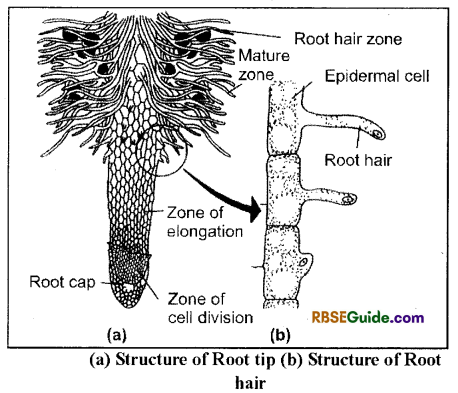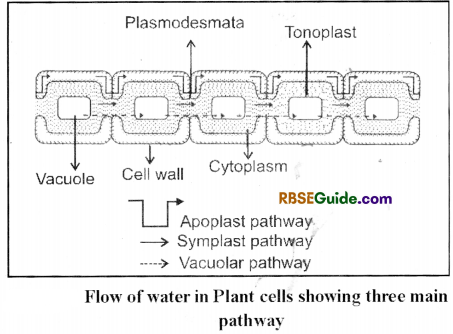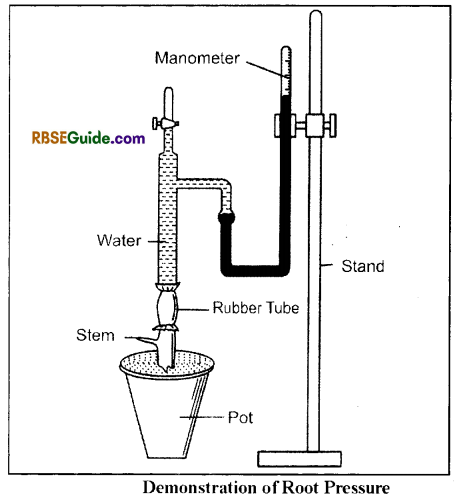Rajasthan Board RBSE Class 12 Biology Notes Chapter 6 Absorption of Water and Ascent of Sap in Plants
Absorption and path way of water
- Absorption of water is an important life activity of plants and it is performed by roots.
- Water is abosrbed by epidermal cells and root hairs present in the terminal part of young root.
- Root hairs are unicellular, uninucleated structures having thin and elastic wall made up of cellulose and pectin.
- Pectin is hydrophilic in nature and root hairs provide greater surface area for absorption of soil water.
- Different substances are absorbed and distributed in plants dissolved in water.
- Source of water for plants is soil water received by soil from rains.
- During heavy rains, the water which runs off on soil surface and passes to ponds, rivers and sea is called run-away water and is not available to plants.
- Water received during mild rains is retained by soil. This is called soil water.
- The soil water may be present in soil as capillary water, gravitational water and hygroscopic water.
- Out of these, only capillary water is easily available to roots and is absorbed by plants.
- The capacity of soil to retain rain water is called water holding capacity or field capacity of soil.
- Water absorbed by root hairs passes to the interior of plant root and finally to the xylem. During this lateral movement, water may follow different paths.
Water absorbing organs of plant
- In thallophytes (Algae and Fungi) water is absorbed by all cells of the plant body.
- In bryophytes unicellular and multicellular rhizoids absorb water.
- In aquatic plants water is absorbed by general surface of plant body.
- In vascular plants (Pteridophytes, Gymnosperms and Angiosperms) rooted in soil, water is absorbed by roots.
![]()
Root has two main parts :
1. Young part
2. Old part.
- Only young part of root performs the function of absorption of water.
- The cells in the old part of root become thick walled due to lignification and suberisation and hence are impermeable to water.
- The young part of root can be differentiated in to following regions.
(i) Root cap
(ii) Region of cell division
(iii) Region of cell elongation
(iv) Root hair region
(v) Mature region.

(i) Root cap or Calyptra: This is the extreme terminal part of root. This is cap like structure and forms a protective covering over the growing tip of root. The root cap protects the meristematic cells of the zone of cell division from friction against soil particles. The cells of root cap are impermeable to water and hence this is not involved in water absorption.
(ii) Region of cell division : This is situated just behind the root cap. The cells in this region are meristematic and divide repeatedly to form new cells resulting into growth of the root. This remains covered by root cap.
(iii) Region of cell elongation : This is situated just behind the region of cell division. The cells are still in the state of division and elongate longitudinally many times of their normal length. Hence it is called region of elongation. This pushes the root tip further deep in the soil.
(iv) Root hair region : This is situated just behind the region of cell elongation. The cells of this region stop dividing and begin to differentiate. The cells of outer most layer of this region produce hair like out growth called root hair. The cells in this zone have thin and elastic walls. This part of root is mainly associated with absorption and hence root hair region of roots is also called water and mineral absorption region.
![]()
(v) Mature region : The cells of this region are fully differentiated. Thicknening deposition (lignification and / or suberization) takes place according to their differentiation pattern. This part of root does not perform water absorption.
Mechanism of Water Absorption
Kramer (1959) explained how water enters in the root hair and the precise mechanism of water albsorption. Accordingly absorption of water in plants is by two independent processes.
(i) Active absorption,
(ii) Passive absorption
(i) Mechanism of Active Absorption
- Absorption of water caused by forces present in the root is called active absorption of water.
- Only 2 to 4% of total water absorbed by plants is absorbed by this method.
- This type of absorption takes place mainly during humid nights when rate of transpiration is very low.
- In active absorption, the cells of root play an important role and due to activity of cells a positive force develops in the xylem of roots which is called as root pressure.
- This theory assumes that water from soil enters in to root against a gradient of DPD and the process requires expenditure of energy which is made available by respiration.
(ii) Mechanism of Passive Absorption
- This is the main method of absorption of water in plants.
- 96 to 98% of water is absorbed by this method.
- During passive absorption, the factors of absorption operate in the transpiring surface of plant.
- Loss of water from the cells of leaves results in shortage of water in these parts and this results in a tension in the water column present in the xylem of veins of leaf.
- This pull is transmitted to the water column of stem and finally to the roots.
- This tension is negative and is called suction force or transpiration pull.
- On account of this, soil water enters root hair and is pulled through root, stem and leaves.
- It should be noted that in passive absorption of water there is no active participation of vital activity of cells of plant.
- The strongest evidence in flavour of this principle is that during high rate of transpiration, absorption of water also takes place rapidly.
Path of Water in Root
Water entering in root hair cells and other epidermal cells of the root moves from these cells through the cortex tissue, the endodermis, the pericycle and finally in to xylem of the root. This is known as lateral flow. This lateral flow of water may take place through three different paths.
(i) Apoplast path,
(ii) Svmplast path
(iii) Vacuolar path
(i) Apoplast path : When water moves exclusively through the cell wall region without crossing any membranes it is called apoplast pathway.
- Apoplast is the continuous system of cell walls and intercellular spaces in the plant tissues.
- In this pathway water moves through diffusion.
The endodermal cells of roots have a peculiar type of thickening. - Here thickening deposition takes place on the walls in the form of strips called Cas parian strips.
- These strips break the continuity of apoplast pathway and water and solutes cross the cell of endodermis by passing through the plasmamembrane. This pathway is known as transmembrane path way.
![]()
(ii) Symplast path :
- When water travels from one cell to the next via plasmodesmata, it is called symplast pathway.
- The symplast consists of entire network of cell cytoplasm inter connected by plasmodesmata.
- In this pathway water has to enter the cell through cell membrane, hence the movement is slower.

(iii) Vacuolar path :
- When water moves from one cell to the next through the plasma membrane, cytoplasm, tonoplast, and the cell sap, it is called vacuolar pathway.
- Osmosis is involved in flow of water in this pathway, and energy is used in the process.
Factors affecting absorption
Absorption of water takes place mainly by passive absorption and this is affected by the following factors :
(i) Available soil water
(ii) Soil aeration
(iii) Soil temperature
(iv) Concentration of soil solution.
(i) Available soil water :
- Water held in capillary spaces between soil particles is called capillary water and is available to roots. This can be easily absorbed by roots and is called available water.
- The rate of absorption is optimum when water in soil is present in the range of field capacity or water holding capacity of soil.
- Tire amount of water held in the soi 1 after all water is drained oft’ due to gravitational force is called field capacity or water holding capacity of soil.
- The percentage of water present in the soil, when the plants growing in it first show permanent wilting, is called permanent wilting percentage.
![]()
(ii) Soil aeration :
- Absorption of water takes palce rapidly in well airated soils such as loam.
- In water logged soils, rate of absorption becomes slow or even becomes zero.
(iii) Soil temperature :
- Ideal temperature for water absorption is 20°C to 30°C.
- Beyond 30°C temperature rate of absorption decreases.
- Below 20°C temperature also rate decreases and at freezing temperature absorption stops altogether.
(iv) Concentration of soil solution :
- Presence of greater amount of dissolved minerals in soil increases concentration of soil solution and under this condition water absorption is greatly reduced.
- Rate of water absorption is high when soil solution is very dilute i.e. amount of dissolved minerals is low.
- The rate of absorption is very low in saline soils.
Path Ascent of Sap
- Water absorbed by roots rises up and reaches to the top of the plant and all other organs.
- Tins upward rise of water and dissolved minera Is from root to other parts of shoot against gravitational force is called ascent of sap.
- This upward rise takes place through the 1 umen (cavity) of vessels and tracheids of xylem tissue.
- This can be demonstrated by the following expeiment.
Path of Acent of Sap
Experiment :
- Dilute solution of safranin is taken in a breaker.
- Safranin is a red coloured stain and stains lignified tissues (Xylem and Sclerenchyma) only.
- The root of Balsam impatiens plant is cut and the cut end of tire plant is dipped in the soluiton in the beaker containing safranin solution.
- After some time (2 to 3 hours), it is obsered that the veins in the leaves show red colour of safranin.
- When a transver section of petiole or branch is observed under microscope, red colour of safranin is seen in cells of xylem tissue.
- This experiment clearly shows that, upward rise of water and dissolved minerals in plants, takes place t bi o ugh xylem.
Mechanism of Ascent of Sap
To explain the upward rise of water and dissolved minerals against gravitational force, several theories have been put forwarded.
These theories have been divided in to three categories :
(A) Vital Force theories
(B) Root Pressure theory
(C) Physical Force theories
(A) Vital Force Theories :
- According to these theories ascent of sap is the result of force developed by activities of living cells.
- Openions expressed by some scientists in this regard are as follows :
(a) Relay Pump Theory :
- According to Godlewski (1884), the living cells of xylem parenchyma and medullary rays show periodic change in their osmotic pressure.
- According to this theory the upward movement of water is due to the force created by pumping activity of wood parenchyma and cells of medullary rays :
![]()
(b) Strasburger (1891) experimentally proved that ascent of sap is not due to the activity of living cells and the process is independent of the living cells of xylem tissue. Howev er, their presence may provide favourable conditions for the process of ascent of sap.
(c) Pulsation Theory:
- Sir J.C. Bose (1923) strongly advocated a vital force theory for ascent of sap, which is known as pulsation theory.
- According to this theory, the cells of innermost layer of cortex, just outside the endodermis show rhythmic pulsation which causes pumping of water from cell to cell in upward direction.
- J.C. Bose experimented on Indian telegraph plant (Desmodium gyrans) to demonstrate rhythmic pulsation activity of the cells of innermost layer of cortex.
(B) Root Pressure Theory :
- The positive pressure found in the sap of xylem vessles of root is called root pressure.
- Inward flow of water in the parenchyma cells of cortex of roots creates a tension on the elastic wall of these cells.
- Due to accumulation of water, a hydrostatic pressure is developed in these cells.
- When the walls tend to return to their origin state, some amount of sap is forced in to the tracheary elements of xylem.
- On account of this, a pressure develops on the water column of xylem due to which it rises up.
- This positive pressure developed on the sap of the tracheary’ elements is called root pressure.
- Root pressure can be demonstrated and may be measured with the help of manometer (Fig. 6.3)
- The value of root pressure in plants is up to 2.0 atm.
- Water may rise up to 20.0 meter height by 2.00 atm pressure.
- In very tall woody trees a pressure of 12 atm. is required for ascent of sap.
- In no plant under any condition such a high value of root pressure has been seen to develop.
- Gymnosperms include some of the tallest trees and root pressure has not been observed in gymnosperms.
- Hence the theory of root pressure has some limitations because it can be of significance in some plants under some conditions only.

(C) Physical Force Theories :
- These theories explain that acent of sap is due to the physical forces and not due to the activity of living cells of plant.
- Different scientist have forwarded opinion in favour of different forces responsible for ascent of sap.
- These forces are atmospheric pressure, capillary force, imbibition force and transpiration pull and cohensive force.
Transpiration Pull and Cohesive Force Theory
1. This theory was proposed by Dixon and Jolty (1894) and at present, it is the most accepted principle for explaining ascent of sap.
2. Transpiration pull and cohesive force are the main features of this theory.
3. In the plant body there is found a continuous water column from leaf up to the root, through xylem ducts.
4. This is named as hydrostatic system.
![]()
5. Loss of water in the mesophyll cells creates a pull in the water column ofveins of leaves. This is called transpiration pull.
6. Due to continuous loss of water, by transpiring cells the whole water column comes under a pulling force.
7. As a result the water column is pulled up from root to leaves.
8. Continuity of water column in xylem is due to cohesive force between water molecules. This force may be as high as 45 207 atm.
9. The water column is pulled up due to transpiration pull and continuity of water column is maintained by cohesive force between water molecules.
10. According to this theory metabolic energy of cells is not used, and activity of living cells is not directly involved in upward rise of water.
11. This theory receives support from several evidences, such as. the rate of transpiration has a direct bearing on ascent of sap and during day time when rate of transpiration is high, the water column in the tree trunk is under tension due to transpiration pull.
